How to measure customer experience (CX) & metrics to help you do it
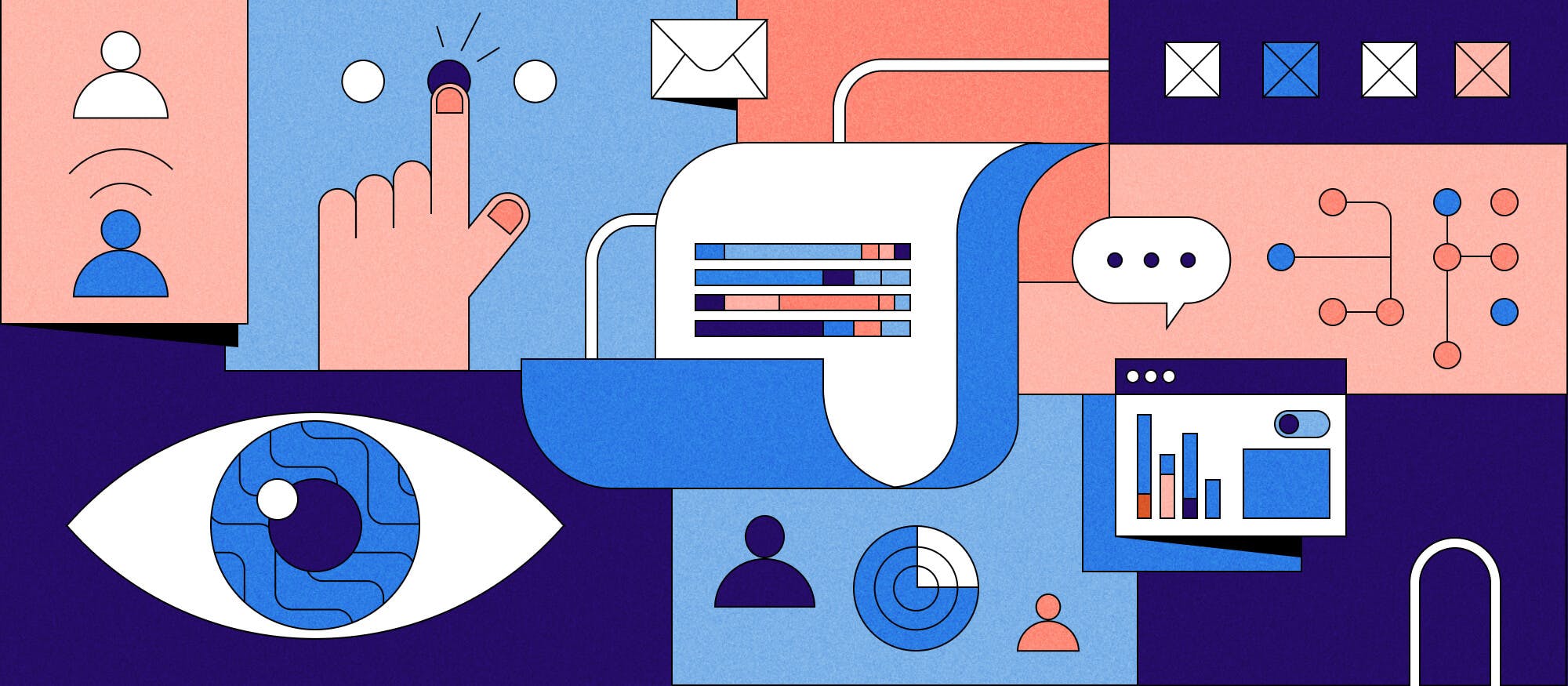
According to Forrester's U.S. 2022 Customer Experience Index, nearly one in five brands saw a drop in the quality of their customer experience in 2022.
All the while, modern customers continue to have higher and higher expectations for brands.
So how can companies reverse the CX trends we're seeing? The first step to fixing customer experience quality issues is being able to measure customer experience quality.
What is customer experience (CX)?
Customer experience (CX) refers to a customer's overall perception and satisfaction with a brand or company based on their interactions across various touchpoints, including before, during, and after a purchase or engagement.
CX encompasses every aspect of the customer journey, from the initial awareness and discovery of a brand, to the purchasing and post-purchase experiences, to ongoing engagement and support.
A positive customer experience can increase customer loyalty, advocacy, and repeat business. But a poor experience can result in customer churn, negative word-of-mouth, and a damaged reputation. That's why measuring the customer experience is a crucial priority for companies — and why so many invest in improving their customer experience through tactics like personalized interactions, seamless omnichannel experiences, and empathetic customer support.
Why does customer experience matter?
Measuring customer experience can help brands in a number of important ways, including:
Revenue + retention: According to PWC, 73% of customers say that a good experience is key in influencing brand loyalty. PWC also found that 86% of customers are willing to pay more for a better customer experience (16% more on average, but the more expensive the item, the more they are willing to pay). That might be part of the reason why companies can expect 70% higher revenue within three years of investing in their customer experience.
Differentiation: Today's competitive marketplace has turned customer experience into a key differentiator between brands. With so many options available, customers are more likely to choose a company that offers a better experience over one that does not.
Quantitative data: Customer experience measurement provides brands with quantitative data that can be used to pinpoint specific issues that customers are facing. For example, by looking at customer satisfaction scores or net promoter scores, brands can identify areas where customers are particularly dissatisfied or where they are likely to recommend the brand to others.
Qualitative data: Customer feedback collected through surveys or other methods provides qualitative data that helps brands understand the root causes of customer dissatisfaction. For example, feedback may reveal that customers are frustrated with a particular checkout process or are confused about how to use a product.
Customer journey improvement: By measuring customer experience along the customer journey, brands can identify previously invisible pain points and highlight areas where improvements can be made.
Comparative analysis: CX measurement can also compare the brand's performance with its competitors. By benchmarking against competitors, brands can identify areas where they are falling short and take steps to improve their customer experience to better compete in the marketplace.
Between boosting revenue and retention, setting your business apart in a crowded market, and providing the data you need to make informed business moves, it’s clear that companies that prioritize customer experience are more likely to succeed in the long run.
Here’s where to begin.

Virgin Mobile UAE improved their CSAT with Sendbird Desk.
A good customer experience starts with Sendbird
Customer experience has always been an important consideration for brands. But in the Social+ age, where customers expect brands to be online, active, and available around the clock, strategies that leave a lasting good impression have become all the more important.
When it comes to mobile customer experience, that means building a robust and comprehensive communication strategy for your brand — and that needs to include in-app messaging.
In-app messaging puts customers at the center of your brand experience. Whether you're initiating a social exchange, suggesting a product, answering a service question, or closing a sale, being able to communicate with customers — seamlessly, instantly, and with personalized interactions — drives engagement, transactions, and a better customer experience.
Sendbird chat API allows you to embed a feature-rich and fully functional chat platform into your app without building it yourself. You can customize it with your own branding so it looks seamlessly built-in, you own all the customer data, and, best of all, you can have it up and running in minutes.
Learn why Sendbird is trusted by 2 billion users across apps: Talk to sales today.

[FREE TOOL] How does your app's engagement score compare to industry standards?
How to measure the customer experience
Customer experience measurement is the first step to customer experience improvement. Here are the core customer experience measurement tools you can use to gather data and insights:
Surveys: Brands can use surveys to collect quantitative and qualitative data about the customer experience. Surveys can be sent out after a customer makes a purchase, interacts with customer service, or engages with the brand in any other way.
Social media listening: Brands can use social media listening tools to monitor customer sentiment and gather feedback about the customer experience. By monitoring social media conversations, brands can identify trends and areas of concern.
User testing: User testing involves asking a group of users to interact with products and services to identify usability issues and other areas for improvement. Brands can use this tool to improve the ease of use of their products and services, which can lead to a better overall customer experience.
Customer interviews: One-on-one interviews can help brands gain a deeper understanding of customer needs and pain points, and identify areas for improvement.
Metrics: Metrics may be the most important tool for measuring and improving customer experience. They help brands set goals, track progress, identify trends, benchmark performance, and continue improving their customer experience over time.
Top 10 metrics for measuring customer experience
By using metrics to measure and improve their customer experience, brands can gain a comprehensive understanding of customer needs and preferences, and take action to address issues and build stronger relationships with their customers. This, in turn, can drive customer loyalty, advocacy, and business growth.
With that in mind, here are the top 10 metrics to track for measuring and improving customer experience.
1. Customer satisfaction (CSAT)
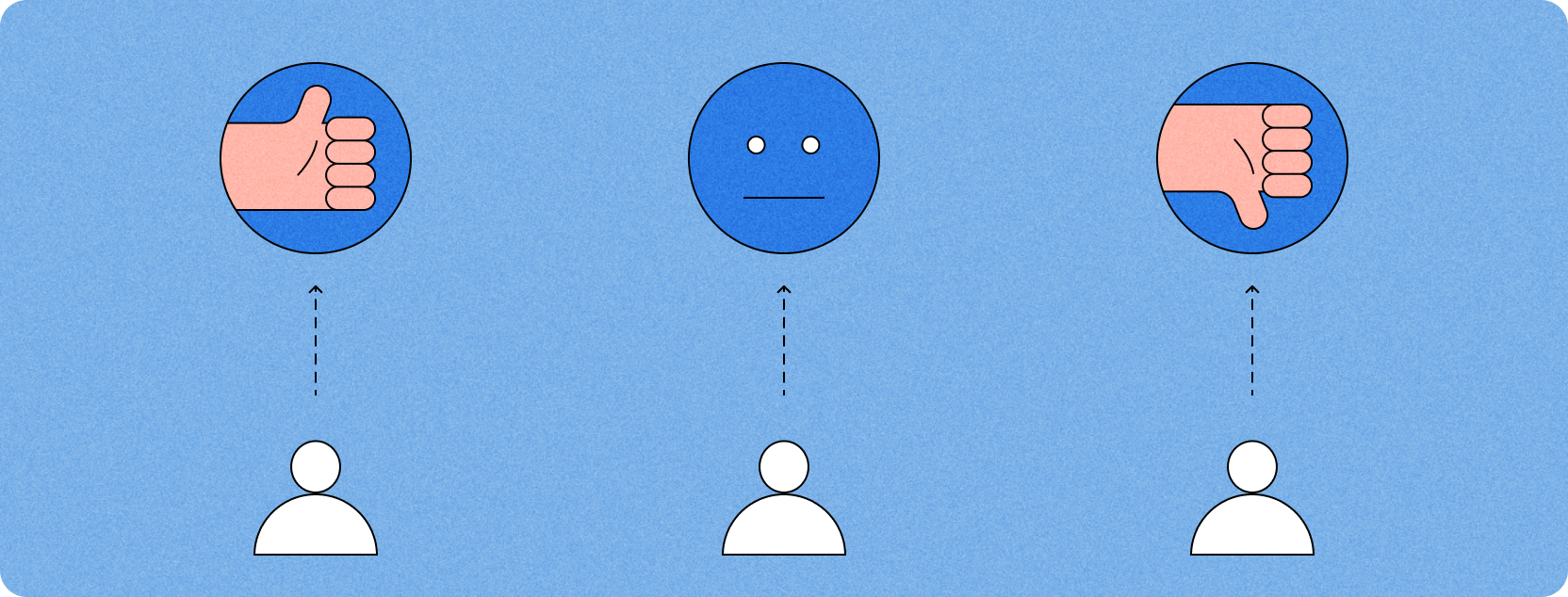
What it is:
Customer satisfaction (CSAT) is a metric that measures how satisfied customers are with a specific interaction, product, or service.
Why it's useful:
CSAT is a valuable metric because it provides insight into how well a brand is meeting the needs and expectations of its customers. By measuring CSAT, brands can identify areas of the customer journey that are causing dissatisfaction.
CSAT surveys are often used after specific interactions or transactions: customer service calls, purchases, or website visits. By collecting feedback after these interactions, brands can quickly identify areas where customers are experiencing issues and take action to address these issues.
In addition to providing insight into the customer experience, CSAT is also a valuable metric for measuring the overall health of a brand's customer relationships. Brands that consistently score high on CSAT are likelier to have loyal customers willing to make repeat purchases and recommend the brand to others.
How to measure it:
CSAT is typically measured through a survey question that asks customers to rate their level of satisfaction with the product, service, or interaction on a scale of 1 to 5 or 1 to 7.
The question is usually some variation of "How satisfied were you with [the product/service/interaction]?" The response options range from "very dissatisfied" to "very satisfied."
How to improve it:
Businesses can improve their CSAT score by:
Prioritizing delivering a high-quality product or service that meets or exceeds customer expectations. This can involve investing in product design, quality control processes, and customer support.
Providing exceptional customer service, including timely and helpful responses to customer inquiries or complaints.
Gathering and acting on customer feedback to continually improve their products and services over time.
2. Net promoter score (NPS)
What it is:
Net promoter score (NPS) is a customer loyalty metric that measures how likely customers are to recommend a brand to others. It is based on the idea that highly satisfied customers with a brand are more likely to recommend it to their friends and family.
NPS is typically measured through a survey question that asks customers to rate their likelihood of recommending the brand to others on a scale of 0 to 10. Based on their response, customers are categorized into three groups:
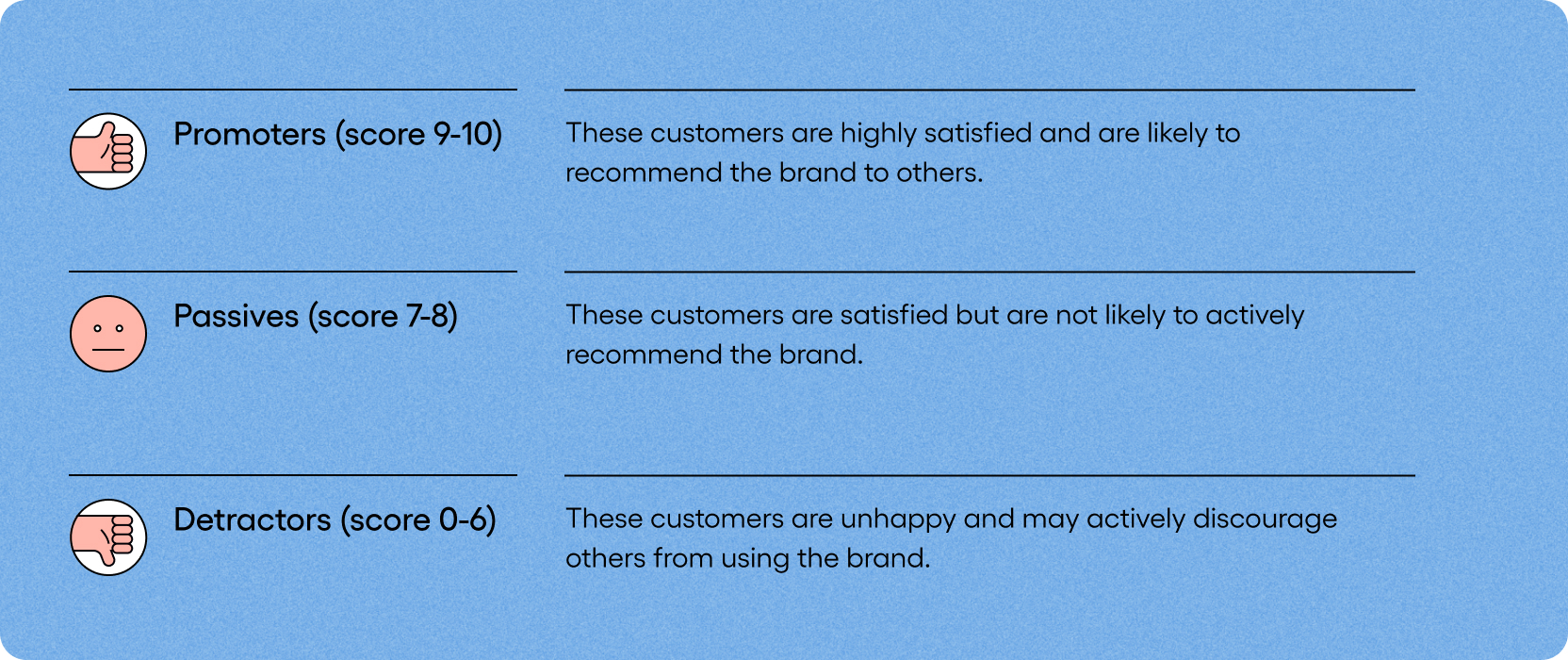
Promoters (score 9-10): These customers are highly satisfied and are likely to recommend the brand to others.
Passives (score 7-8): These customers are satisfied but are not likely to actively recommend the brand.
Detractors (score 0-6): These customers are unhappy and may actively discourage others from using the brand.
Why it's useful:
NPS is valuable because it provides insight into customer loyalty and brand advocacy. By measuring NPS, brands can identify areas where they may fall short in customer satisfaction. Additionally, brands can use NPS to benchmark their performance against competitors and industry standards.
NPS is widely used in various industries, including retail, hospitality, and financial services, among others. By regularly measuring and monitoring NPS, brands can understand customer sentiment comprehensively and take action to improve customer loyalty and advocacy.
How to measure it:
To calculate NPS, the percentage of detractors is subtracted from the percentage of promoters. The resulting score ranges from -100 to 100, with higher scores indicating a more positive brand reputation.
How to improve it:
Improving NPS is a crucial objective for many businesses since it's such a clear measure of customer loyalty and advocacy. Brands can improve their NPS score by:
Delighting customers, both through the product or service and through interactions with the brand across all channels.
Providing fast, effective, and empathetic customer support, especially when something goes wrong.
Building strong relationships with customers through targeted marketing and engagement campaigns.
3. Customer effort score
What it is:
Customer effort score (CES) is a customer experience metric that measures the ease of a customer's interaction with a brand.
Why it's useful:
CES is a valuable metric because it provides insight into the customer experience beyond just satisfaction. A customer may be satisfied with the outcome of their interaction, but if it required a high level of effort, they may be less likely to return in the future or recommend the brand to others. By measuring CES, brands can identify areas of the customer journey that are causing frustration and friction.
CES is particularly useful in customer service interactions, where customers often seek quick and easy solutions to their problems. By reducing customer effort in these interactions, brands can improve customer satisfaction and build stronger customer relationships.
How to measure it:
CRR is typically measured through a survey question that asks customers to rate the effort required to complete a specific task or interaction, such as making a purchase or resolving an issue.
This question is typically some variation of "How easy was it to [complete the task]?" The response options are usually on a scale of 1 to 5 or 1 to 7, with 1 indicating "very difficult" and 5 or 7 indicating "very easy."
How to improve it:
Brands can improve their CES score by:
Simplifying their products or services to reduce the effort required from customers. This may mean investing in user-friendly interfaces, streamlining the checkout process, or implementing intuitive navigation.
Acting on customer feedback to continually improve and reduce the customer effort required.
4. Customer retention rate
What it is:
Customer retention rate (CRR) is a metric that measures the percentage of customers that a brand retains over a specified period of time.
Why it's useful:
CRR is valuable because it provides insight into the health of a brand's customer relationships. Brands with a high CRR are likelier to have loyal customers who make repeat purchases and recommend the brand to others. Retaining existing customers is often more cost-effective than acquiring new customers, making CRR an important metric for assessing the overall profitability of a brand.
How to measure it:
The formula for calculating CRR is:
CRR = ((CE-CN)/CS)) X 100
CE = the number of customers at the end of a period
CN = the number of new customers acquired during the period
CS = the number of customers at the start of the period
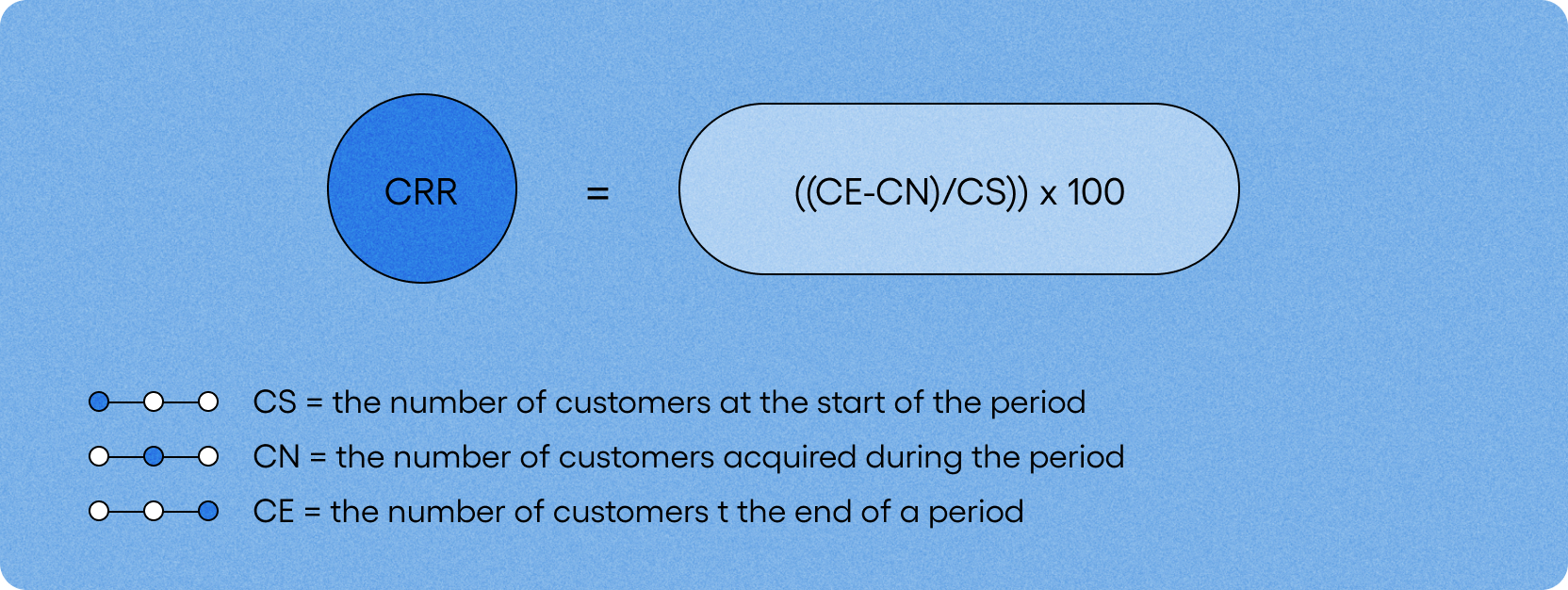
How to improve it:
CRR and CX are closely intertwined. To improve CRR, brands should engage customers through personalized communications and offers and encourage repeat purchases through loyalty programs, gifts, and other incentives.
5. Customer churn rate
What it is:
Customer churn rate (CCR) is a metric that measures the percentage of customers who stop doing business with a brand over a specified period of time.
Why it's useful:
Customer churn matters because it's another metric that reveals the health of a brand's customer relationships. Brands with a high CCR are losing customers faster than they are acquiring new ones, which can be a sign of underlying issues in the customer experience, product quality, or customer service.
How to measure it:
The formula for calculating CCR is:
CCR = ((CL/CS)) X 100
CL = the number of customers lost during the period
CS = the number of customers at the start of the period
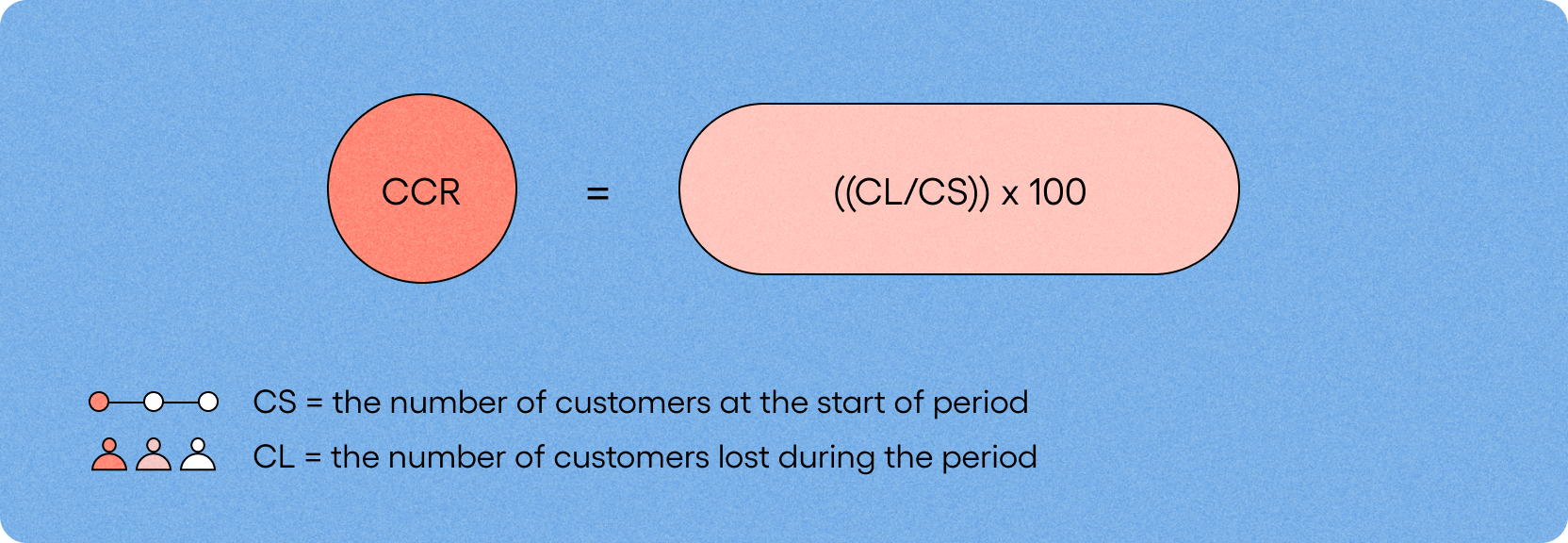
How to improve it:
To reduce CCR, brands can focus on improving the customer experience, addressing customer complaints and concerns in a timely manner, and offering incentives for customer loyalty. They can also use customer feedback and data analysis to identify the root causes of customer churn and take action to address these issues.
Reducing CCR is essential for maintaining business profitability — acquiring new customers is almost always more expensive than retaining existing ones. By improving customer retention, brands can increase customer lifetime value and build stronger, more profitable customer relationships.
6. Average resolution time (ART)
What it is:
Average resolution time (ART) is a metric that measures the average time it takes for a brand to resolve customer issues or complaints.
Why it's useful:
ART is a valuable metric because it reveals the efficiency and effectiveness of a brand's customer service or support operations. Brands with higher ART numbers may experience longer wait times or delays in resolving customer issues, negatively impacting customer satisfaction and loyalty.
How to measure it:
The formula for calculating ART is:
ART = Total time spent resolving issues / Number of issues resolved
How to improve it:
To improve ART, brands should streamline their customer service or support processes, provide training and resources to support agents and leverage technology and automation to handle routine customer inquiries. Brands can also use customer feedback and data analysis to identify areas where their customer service or support operations may be falling short and take action to address those issues.
7. First contact resolution (FCR)
What it is:
First contact resolution (FCR) is a metric that measures the percentage of customer inquiries or issues that are resolved on the first contact with a brand's customer service or support team.
Why it's useful:
FCR is valuable because it shows how efficient and effective your support teams are. Brands with high FCRs can quickly and completely address customer inquiries and issues.
How to measure it:
The formula for calculating FCR is:
FCR = (Number of inquiries resolved on the first contact / Total number of inquiries) x 100
How to improve it:
To improve FCR, brands can focus on providing comprehensive training and resources to their customer service or support agents, using technology (especially automation) to streamline processes and reduce wait times, and regularly collecting and analyzing customer feedback to identify areas for improvement. Resolving customer inquiries and issues on the first contact helps brands demonstrate their commitment to customer service excellence.
8. Monthly active users (MAU)
What it is:
Monthly active users (MAU) is a metric used to measure the number of unique users who engage with a brand's product, website, or application within a given month. It provides a snapshot of user engagement and tracks user growth and retention over time.
Why it's useful:
MAU is important because it helps brands measure the popularity and engagement of their product or service. Brands with a lot of MAU are typically able to attract and retain a large number of users, which can be a key indicator of brand loyalty, customer engagement, and customer satisfaction.
How to measure it:
MAU is calculated by counting the number of unique users who engage with your product, website, or app during a specific month.
How to improve it:
To improve MAU, brands can focus on improving the user experience of their product or service, increasing the value proposition for users, and implementing effective marketing and user acquisition strategies.
9. Trial-to-paid conversion rate
What it is:
Trial-to-paid conversion rate is a metric that measures the percentage of users who convert from a free trial or demo of a product or service to a paid subscription or purchase. This metric is often used to assess the effectiveness of a brand's marketing and sales strategies.
Why it's useful:
Trial-to-paid conversion rate is a valuable metric because it reveals how effective a brand is at converting trial users into paying customers. Brands with high conversion rates can effectively demonstrate the value of their product or service and convince users to make a longer-term commitment, which drives higher revenue over time.
How to measure it:
The formula for calculating trial-to-paid conversion rate is:
Trial-to-paid conversion rate = (Number of paying customers / Number of trial users) x 100
How to improve it:
To improve trial-to-paid conversion rate, brands should focus on providing a high-quality trial experience, delivering a compelling value proposition to users, and implementing effective sales and marketing strategies to drive conversion. Converting trial users into paying customers is a key driver of revenue and growth.
10. Customer referral rate
What it is:
Customer referral rate is a metric that measures the percentage of existing customers who refer new customers to a brand's product or service. This metric is used to assess the effectiveness of a brand's customer referral program and to measure customer loyalty and satisfaction.
Why it's useful:
Your customer referral rate provides insight into the willingness of existing customers to recommend your product or service to others. Brands with high referral rates can leverage the power of word-of-mouth marketing to acquire new customers at a low cost while also building stronger relationships with their existing customers.
How to measure it:
The formula for calculating customer referral rate is:
Customer referral rate = (Number of new customers referred / Total number of customers) x 100
How to improve it:
To improve customer referral rate, focus on providing a high-quality product or service, delivering exceptional customer service, and implementing a well-designed customer referral program that offers appealing incentives for existing customers to refer new ones. Build a sustainable and profitable business model, especially because word-of-mouth marketing is one of the most cost-effective ways to acquire new customers.
Track customer experience metrics while keeping customers at the heart of your business
By enabling real-time communication between brands and their customers, Sendbird helps brands offer better support, answer customer queries more quickly, and resolve issues more efficiently.
In addition to messaging capabilities, Sendbird also provides analytics and reporting tools to help brands measure and analyze customer behavior. As the leading AI customer experience platform, Sendbird can help you track and measure many of the most important CX metrics, so you can build your understanding of your customers' needs and preferences — then optimize the customer journey and improve overall customer experience.
Ready to take your CX to the next level with Sendbird? Talk to sales today.










